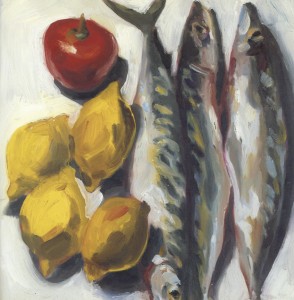What It Means To Be Civilized
As part of this month’s CDL homework, I’ve been reading selections from “Taming the Ox: Buddhist Stories and Reflections of Politics, Race, Culture and Spiritual Practice“, by Charles Johnson (pictured above, who will be a guest speaker at our next training retreat in September).
Here’s a passage that strikes me as particularly important–and timely–even though (maybe especially because) it was written more than 10 years ago:
“….At stake in the Martin Luther King, Jr. story are not only questions about American race relations but also deeper issues, older conundrums about what it means to be civilized in the political and social world, about how one confronts social evil without creating evil, division, and enmity, even questions about what Buddhists call pattica samuppada (Dependent Origination) that resonate beneath the surface of King’s remarkable and too-brief thirty-nine years of life.
“Clearly these are matters of urgency–especially the demand for civility–when in our spiritually bankrupt world awash in pop-culture vulgarity and terrorist acts…our leaders during the last presidential campaign [2004], on both the left and the right, shamelessly employed in their desire to ‘win’ such tactics as mudslinging and character assassination. (Prescient, King once stated, ‘We shall have to create leaders who embody virtues we can respect,’ and also counseled, ‘We must be sure that our hands are clean in the struggle.’)
“Would that today’s arrogant, ankle-biting and so often shortsighted politicians, with their red-meat rhetoric, might remember what King told Freedom Riders in 1960: ‘Our ultimate end must be the creation of the beloved community.'”
Let None Wish Others Harm
 The December homework for the CDL (Community Dharma Leader) program has just arrived. The focus this month is on what Sharon Salzberg calls our Four Best Homes…the four Brahma Viharas, also translated as the four Divine Abodes: Metta (Loving Kindness), Karuna (Compassion), Mudita (Joy in the Happiness of Others) and Upekkha (Equanimity).
The December homework for the CDL (Community Dharma Leader) program has just arrived. The focus this month is on what Sharon Salzberg calls our Four Best Homes…the four Brahma Viharas, also translated as the four Divine Abodes: Metta (Loving Kindness), Karuna (Compassion), Mudita (Joy in the Happiness of Others) and Upekkha (Equanimity).
One of our assignments is to do a formal practice for each of the Brahma Viharas for one week during our sitting practice. That is: each day for a full week, do Metta practice during one entire sitting period. Then move to Compassion, then Joy, then finally Equanimity. As a support for this, the teachers sent the text of the Metta Sutta in its original Pali (the first language used to record the Buddha’s teachings) along with an English translation that’s slightly different from the one I heard the first time I encountered these teachings. I like it a lot. So I offer it here, for your welfare and benefit:
This is what should be done
By one who is skilled in goodness
Having glimpsed the state of perfect peace,
Let them be able, honest and upright,
Gentle in speech, meek and not proud.
Contented and easy to support,
With few duties, and simple in living.
Tranquil their senses, masterful and modest,
without greed for supporters.
Also, let them not do the slightest thing
That the wise would later reprove.
Let them cultivate the thought:
May all be well and secure,
May all beings be happy.
Whatever living creatures there be,
Without exception, weak or strong,
Long, huge or middle-sized,
Or short, minute or bulky,
Whether visible or invisible,
And those living far or near,
The born and those seeking birth,
May all beings be happy.
Let none deceive another
Or despise any being in any state;
Let none wish others harm
In resentment or in hate.
Just as with her own life
A mother shields her child,
Her only child, from hurt
Let all-embracing thoughts
For all beings be yours.
Cultivate a limitless heart of goodwill
For all throughout the cosmos,
In all its height, depth and breath —
Love that is untroubled
And beyond hatred or enmity.
As you stand, walk, sit or lie,
So long as you are awake,
Pursue this awareness with your might:
It is deemed the Divine Abiding — here and
now.
Holding no more to wrong views,
A pure-hearted one, having clarity
Of vision, being freed from all sense desires,
Is not born again into this world.
After the Spell was Broken
 Last month’s homework for the CDL (Community Dharma Leader) program I’m in was to “write a vignette from your own life that expresses an aspect of…and hopefully, an insight into…one or more of the Four Noble Truths.” Here’s what I wrote:
Last month’s homework for the CDL (Community Dharma Leader) program I’m in was to “write a vignette from your own life that expresses an aspect of…and hopefully, an insight into…one or more of the Four Noble Truths.” Here’s what I wrote:
Once upon a time (when I was in my late 20s), I fell in love with a man who was creative and passionate and sensitive and successful….who took me on fabulous trips and gave me beautiful gifts he made by hand…who loved art and music…and could cook!…but who also, it turns out, had….“issues.” At the time, I didn’t fully understand the situation. I just thought he was afraid of making a commitment.
Commitment, however, was something I very much wanted – so naturally, there was a lot of suffering. I was not practicing meditation at the time. I didn’t know what meditation was and I hadn’t heard of the Dharma. I like to think now that if I had been practicing, I would have seen what was going on and would have gotten “off the wheel” of that particular suffering right away. But I didn’t. And the situation went on – with LOTS of suffering – for 13 years.
If anyone had asked me back then if I understood suffering (First Noble Truth: There is suffering. It is to be understood.), I would have said “YES, of course, I am suffering!!!”
But I didn’t really understand the suffering. The situation was so painful and I was so unable to let myself fully FEEL the pain, that I couldn’t see that I was suffering NOT because I couldn’t get him to make a full-hearted commitment to me, but because I was clinging to a fantasy….to the belief that at some time in the future the relationship WOULD BE happy, satisfying and healthy. (The Second Noble Truth: The cause of suffering is clinging. It is to be let go of.) But I couldn’t let go of my belief in the fantasy relationship because I wouldn’t let myself see – and experience – the relationship I was actually in.
So it went on….(and off and on and off and on)….for 13 years. Until one day, completely by accident, I stumbled upon the fact that several years prior, he had purchased a house (quite a large, palatial house) and had moved there – along with another woman. I was stunned. (Hurt. Angry. Furious. Etc. Etc.)
But it was such a shock that somehow my normal, quite-well-developed habit of denial didn’t get the chance kick in and hide what I was actually experiencing. So I really SAW the relationship I was in….and immediately the fantasy disappeared. I didn’t have to “let go” of it – it was just GONE. And in that moment, even with all the shock and shame and anger and sadness….there was peace. I had not expected it, but it was there. I had seen clearly; the spell was broken; there was peace. (Third Noble Truth: There is an end to suffering. It is to be experience.)
I still had to work through all the grief, pain, humiliation, rage, etc., but that was do-able. I wasn’t stuck any more. The process wasn’t quick. Or easy. But the knot was gone and all those painful, even devastating feelings could come….and go. I wasn’t stuck. I was free.
What 3?
 There was an interesting exercise this week in the homework for the on-line Abhidhamma course I’m taking. The topic is the 10 Beautiful Qualities of Mind/Heart (called Parami, in Pali), which are mental legacies that can be developed and then passed on from one mind-moment to the next (and, according to the teachings, from one lifetime to the next).
There was an interesting exercise this week in the homework for the on-line Abhidhamma course I’m taking. The topic is the 10 Beautiful Qualities of Mind/Heart (called Parami, in Pali), which are mental legacies that can be developed and then passed on from one mind-moment to the next (and, according to the teachings, from one lifetime to the next).
These 10 Beautiful Qualities on Mind/Heart are:
Generosity
Non-Harming (Ethical Conduct)
Renunciation
Wisdom
Energy
Patience
Truthfulness
Resolve/Determination
Lovingkindness
Equanimity
The exercise was to rank these qualities in the order of their prevalence, predominance or frequency in our own heart/mind. Then to select the 3 we felt were most developed (i.e. our default setting) and the 3 most absent. Then to reflect on why these were chosen, and on what benefit/suffering has been present in our life as a result.
Interesting.
I chose Resolve, Energy and Non-Harming as my 3 most developed. And Renunciation, Equanimity and Patience as my 3 most absent.
Hmmm.
So now the exercise is: what personal activity, belief, attitude, emotion, etc. must be let go of in order to further develop the 3 most lacking?
OK. This is the hard part.
Stay tuned.
***
(image: Three of a Kind, by Sharon Atkinson)
Just Listen
 I’ve posted earlier about reading the Satipatthana Sutta out loud and having an experience that was closer to a visceral feeling of the words than a conceptual understanding of them. (full post here.) It was the English translation I was reading, of course, so I did understand what I was reading. But the repetition and the archaic style made it closer to music than text.
I’ve posted earlier about reading the Satipatthana Sutta out loud and having an experience that was closer to a visceral feeling of the words than a conceptual understanding of them. (full post here.) It was the English translation I was reading, of course, so I did understand what I was reading. But the repetition and the archaic style made it closer to music than text.
I had a similar-but-different experience of “knowing” the words — but in Pali this time — when I listened to an extraordinarily beautiful recording of the entire sutta, chanted by a Sri Lankan monk, Ven. Omalpe Sobitha Thero.
I offer it to you here, for your pleasure, and for whatever understanding comes with the experience:
To listen, start by clicking here. Then scroll down almost to the bottom of the page. Look for the Maha Satipatthana Sutta. Because the recording quality is so high, the file is quite large, so it is broken into four parts. Part 1 is an introduction in English (under 2 minutes). The chanting begins at part 2 (about 20 minutes) and ends with Part 4 (about an hour total).
It’s more than gorgeous.
Just listen.
Out Loud, Four Times
 Part of the CDL homework for this month is to read the Satipatthana Sutta (text on the Foundations of Mindfulness) — OUT LOUD, FOUR TIMES — including all the repetitive parts, which are usually only written out fully the first time they occur, then indicated by ellipses on the MANY occasions when they occur after that. The sutta in book form (with ellipses) is only about 10 pages long, but it is QUITE repetitive, so the actual out-loud reading takes about 20 minutes or more. (When it’s chanted in Pali, it can take about an hour.) The language of the text is somewhat archaic and the style is highly formulaic, so while the study of the practices outlined in the text can be fascinating (and profoundly transformative) the actual READING of the text can be….well…boring.
Part of the CDL homework for this month is to read the Satipatthana Sutta (text on the Foundations of Mindfulness) — OUT LOUD, FOUR TIMES — including all the repetitive parts, which are usually only written out fully the first time they occur, then indicated by ellipses on the MANY occasions when they occur after that. The sutta in book form (with ellipses) is only about 10 pages long, but it is QUITE repetitive, so the actual out-loud reading takes about 20 minutes or more. (When it’s chanted in Pali, it can take about an hour.) The language of the text is somewhat archaic and the style is highly formulaic, so while the study of the practices outlined in the text can be fascinating (and profoundly transformative) the actual READING of the text can be….well…boring.
Here’s a sample: In this way, in regard to the body he abides contemplating the body internally, or he abides contemplating the body externally, or he abides contemplating the body both internally and externally. He abides contemplating the nature of arising in the body, or he abides contemplating the nature of passing away in the body, or he abides contemplating the nature of both arising and passing away in the body.
(See what I mean?)
But anyway, I did it. All four time.
And I loved it!
The first reading was kind of a slog. And the second wasn’t much better. But then I got into a groove on the third reading, and by the fourth, there was an aliveness to it that I definitely had not expected. Partly it was the rhythm of the repetition. Partly it was the chant-like quality of the phrasing. But mostly, I think, it was something else that I can’t quite put my finger on. Something to do with simultaneously saying and hearing the words….the combination of the physical sensation of reading the syllables aloud and the mental experience of understanding the words but not quite “getting” them (because of the archaic usage and phrasing)…that triggered a way of saying and hearing the words that was closer to feeling them than to either speaking or listening.
Very interesting.
Choose Wisely
According to the Samyutta Nikaya, the first of the factors of stream-entry is “association with superior persons.”
A man who wraps rotting fish
in a blade of kusa grass
makes the grass smelly:
so it is
if you seek out fools.
But a man who wraps powdered incense in the leaf of a tree
makes the leaf fragrant:
so it is
if you seek out
the enlightened.
— from the Itivuttaka, translated by Thanissaro Bhikkhu
(image: “A Whole World,” by Couprie and Louchard)
That Which Keeps Us Bound
 “The Ten Fetters” (samyojana) is one of the topics of this month’s DPP homework…which is preparing us for the up-coming retreat on Nibanna. “Fetters” is not a word I use in every-day conversation. But I understand what it means — something that keeps us from moving forward, that holds us back, that keeps us bound.
“The Ten Fetters” (samyojana) is one of the topics of this month’s DPP homework…which is preparing us for the up-coming retreat on Nibanna. “Fetters” is not a word I use in every-day conversation. But I understand what it means — something that keeps us from moving forward, that holds us back, that keeps us bound.
This is part of our readings for this month. It’s from The Isalnd: An Anthology of the Buddha’s Teachings on Nibbana, by Ajanh Pasanno and Ajahn Amaro:
“Although some people may be quicker than others in reaching the goal, the structure of the unfolding insight is common to all. The most familiar description of the stages of realization contains four levels: the stream-enterer (sotapanna), the once-returner (sakadagami), the non-returner (anagram) and one fully enlightened (arahant). These levels are differentiated according to the ‘fetters’ (samyojana) that a liberated person relinquishes at each stage:
Bhikkhus, there are these five lower fetters. What five? Identity view, doubt, the distorted grasp of rules and vows, sensual desire, ill will. These are the five lower fetters. — Samyutta Nikaya 45.179, translated by Bhikkhu Bodhi
Bhikkhus, there are these five higher fetters. What five? Lust for form, lust for the formless, conceit, restlessness, ignorance. These are the five higher fetters. — Samyutta Nikaya 45.180, translated by Bhikkhu Bodhi”
Later on in the text: What now, Sariputta, is a factor for stream-entry? Association with superior persons, venerable sir, is a factor for stream-entry. Hearing the true Dhamma is a factor for stream-entry. Careful attention is a factor for stream-entry. Practice in accordance with the Dhamma is a factor for stream-entry…. One who possesses this Noble Eightfold Path is a stream-enterer. — Samyutta Nikaya 55.5, translation by Bhikkhu Bodhi.
When he attends wisely in this way, three fetters are abandoned in him: personality view, doubt and adherence to rules and observances. These are called the taints that should be abandoned by seeing. — Majjhima Nikaya 2.3 & .9-11 translation by Bhikkhu Nanamoli & Bhikkhy Bodhi
And: “The Eightfold Path which is equated with the stream is often characterized as being composed of three trainings — virtue, concentration (or the higher mind) and wisdom…..If the factors of the path are fulfilled partially, one is able to realize stream-entry. If you fulfill them more completely, you’ll reach the higher attainments. For stream-entry, full accomplishment in virtue is necessary, but only partial accomplishment in concentration and wisdom.”
(image: “Creative Whack Pack,” by Roger von Oech)
Temporary Nibbana
 One of the readings from this month’s DPP homework is Nibbana for Everyone, by Buddhadasa Bhikkhu (translated by Santikaro Bhikkhu). He writes:
One of the readings from this month’s DPP homework is Nibbana for Everyone, by Buddhadasa Bhikkhu (translated by Santikaro Bhikkhu). He writes:
“The word ‘nibbana‘ means ‘coolness.’ Back when it was just an ordinary word that people used in their homes, it meant ‘coolness.’ When it is used as Dhamma language, in a religious context, it still means ‘coolness,’ but refers to the cooling or going out of the fires of defilement (kilesa, reactive emotions), when in common people’s usage it means the cooling of physical fires….
“Any reactive emotion that arises cease when its causes and conditions are finished. Although it may be a temporary quenching, merely a temporary coolness, it still means Nibbana, even if only temporarily…This indeed is the temporary Nibbana that sustains the lives of beings who are still hanging onto defilement [greed, hatred and delusion].
“Anyone can see that if the egoistic emotions exist night and day without any pause or rest, no life could endure it. You ought to consider carefully the fact that life can survive only because there are periods when the defilements don’t roast it, which, in fact, outnumber the times when the defilements blaze…
“Every time the defilements [greed, hatred and delusion] don’t appear, Nibbana becomes apparent to the mind. This kind of Nibbana nourishes the lives of living things so they survive and don’t go crazy…We can experience Nibbana here and now by breathing in cool and breathing out cool. It is the automatic quenching of heat, of thirst, of dukkha [suffering] in ordinatry life, even without our being conscious of it. It is the eternal nourishment and sustenance of life.”
(image: “A Whole World,” by Couprie and Louchard)
Also Known As…
Another part of the DPP homework for this month is to read Mind Like Fire Unbound, by Thanissaro Bhikkhu. In it, he lists a series of similes for nibbana, collected from the Samyutta Nikaya, and our homework assignment is to reflect on these terms. We are asked: “Which ones do you find inspiring? Spend some time allowing yourself to connect with the inspiration of those terms. Do some of them feel uninspiring? Why?” Here’s the list:
 the Unfashioned
the Unfashioned
the End
the Effluent-less
the True
the Beyond
the Subtle
the Very-Hard-to-See
the Ageless
Permanence
the Undecaying
the Surface-less
the Non-Objectification
Peace
the Deathless
the Exquisite
Bliss
Solace
the Exhaustion of Craving
the Wonderful
the Marvelous
the Secure
Security
Nibbana (which literally translates as “coolness”)
the Unafflicted
the Passionless
the Pure
Release
Non-Attachment
the Island
Shelter
Harbor
Refuge
the Ultimate
(image: House of a Thousand Paintings by Sanford Darling)


